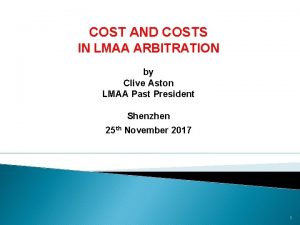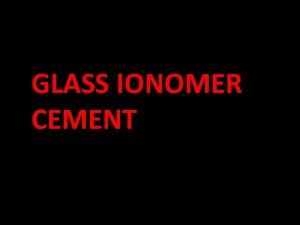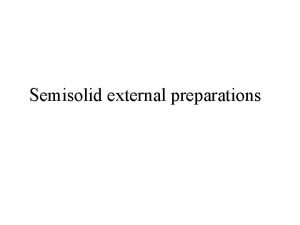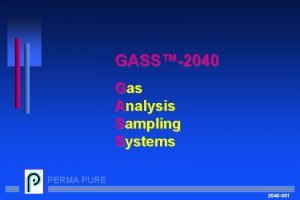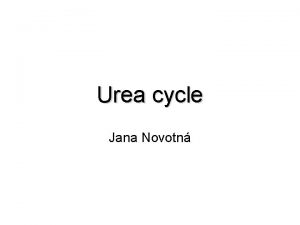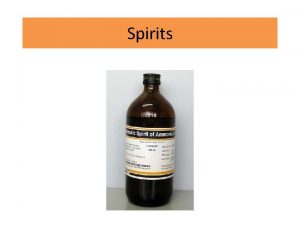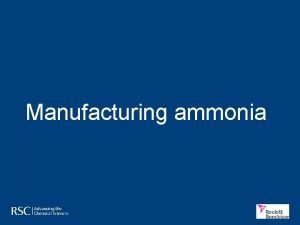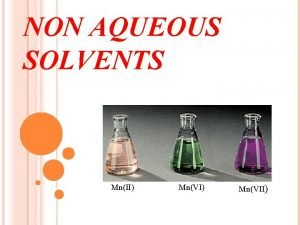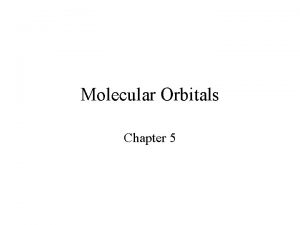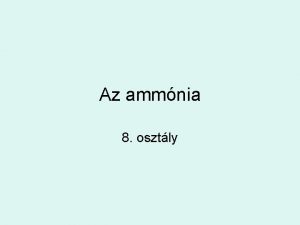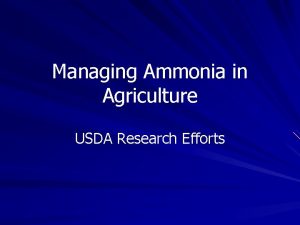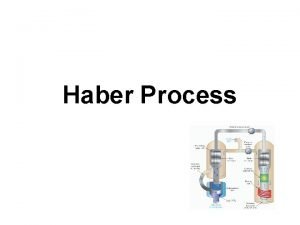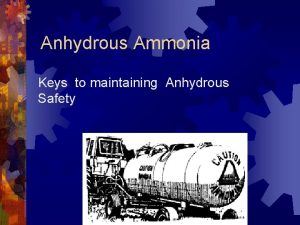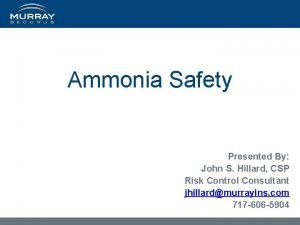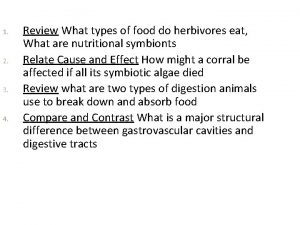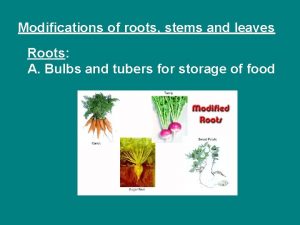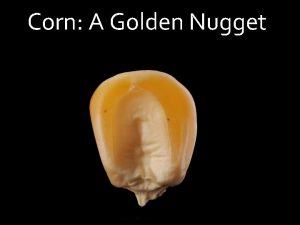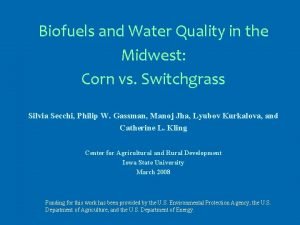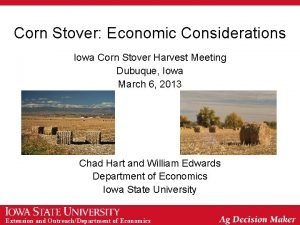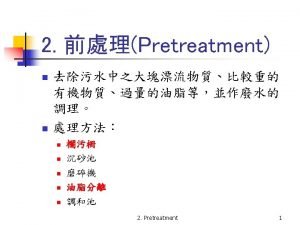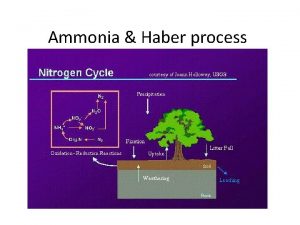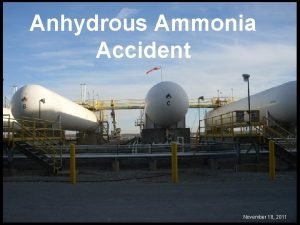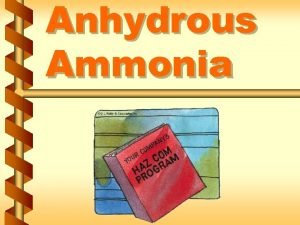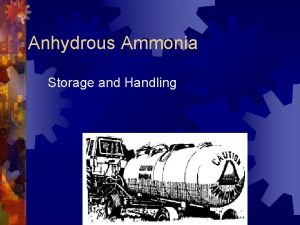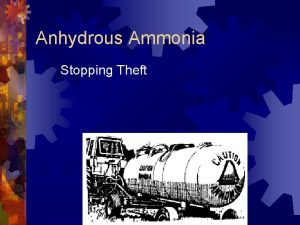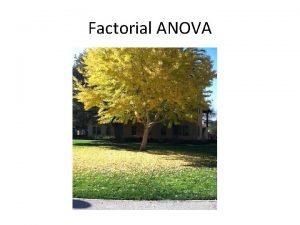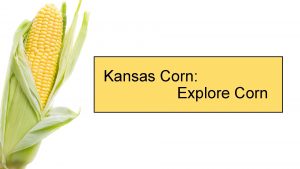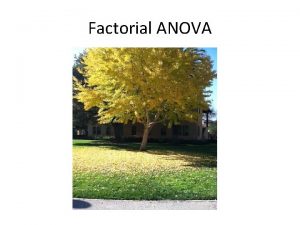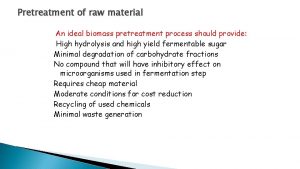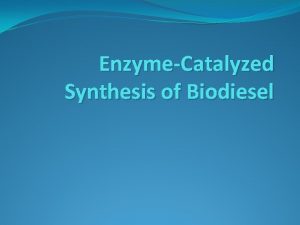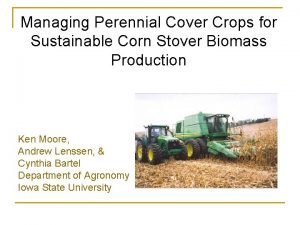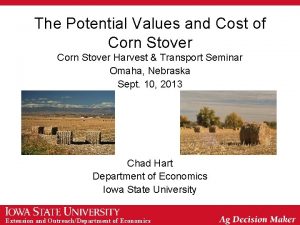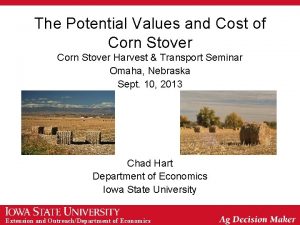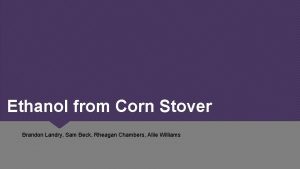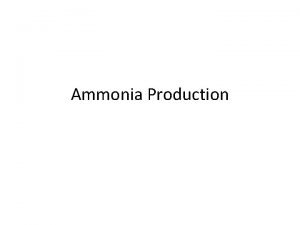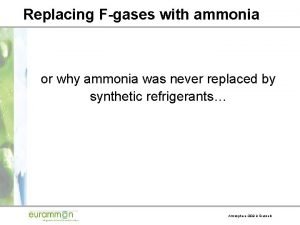LowMoisture Anhydrous Ammonia LMAA Pretreatment of Corn Stover





































- Slides: 37

Low-Moisture Anhydrous Ammonia (LMAA) Pretreatment of Corn Stover Minliang Yang Ming-Hsun Cheng Xiong Cao Kurt A. Rosentrater Department of Agricultural and Biosystems Engineering Iowa State University

Outline 1) Introduction 2) Overall Objectives 3) Optimization Experiments 4) Storage Experiments 5) Conclusions

Introduction Procedure of ethanol production Pretreatment is required for efficient hydrolysis. Cellulose (Glucan, β-1, 4 -glucose) Hydrolysis Glucose (Fermentable) 3

Introduction Pretreatment / Incubation Hydrolysis / Fermentation 4

Overall Objectives • Can we do it? How well does LMAA work? • Will LMAA help storage? • How much will LMAA cost?

Optimization Experiments 6

Batch Reactors Sealed batch reactor (690 m. L): Optimized Conditions: • 0. 1 g ammonia/g biomass, 80°C, 84 h Results: • 89% of the maximum theoretical ethanol yield • 24. 9 g/L ethanol production in fermentation Scaled-up reactor (3 L): 4 x larger Conditions: • 0. 1 g ammonia/g biomass, 75°C, 72 h Results: • 71. 6% of the maximum ethanol yield • $3. 86 /gal of bioethanol

Phase One – Results − Glucan Digestibility of treated vs. untreated corn stover 60 56. 07 Digestibility (%) 50 40 trt cp 30 25. 66 untreated 20 10 0 0 20 40 60 80 Time (h) 100 120 140 160 *Note: Conditions for untreated treatment: 50% moisture content and medium size; Conditions for optimal treatment: 72 h, 75°C, 50% moisture content and medium size. Compared with untreated corn stover, LMAA pretreatment method greatly improved enzymatic digestibility (% improvement=119) 8

Phase Two – Results − Glucan Digestibility of treated vs. untreated corn stover 71. 6 ° *Note: Conditions for untreated treatment: 50% moisture content and medium size; Conditions for optimal treatment: 72 h, 75°C, 50% moisture content and medium size. Compared with untreated corn stover, LMAA pretreatment method greatly improved enzymatic digestibility (% improvement=213) 9

Phase Two – Results % digestibility 80 70 71. 6 60 60. 3 58. 0 50 40 144 h 24 h 30 75 h 20 10 0 0 50 100 150 Time (h) * Note: Conditions for 144 h treatment: 144 h, 120 C, 80% moisture content and large size; Conditions for 24 h treatment: 24 h, 120 C, 80% moisture content and large size. Longer incubation time may improve digestibility, but not very obvious. *Note: Conditions for 20 C treatment: 24 h, 20 C, 80% moisture content and small size; Conditions for 120 C treatment: 24 h, 120 C, 80% moisture content and small size. Lower incubation temperature may improve digestibility compared with higher. 10

Experimental Modifications Output Original setup Input Modified setup Input Output Ammonia loading: 0. 1 g/g biomass 0. 18 g/g biomass Ø Optimization of LMAA conditions Ø Increase glucan digestibility ü Ammonia diffusion ü Hydrolysis conditions 11

Ammoniation & Pretreatment Modifications Pretreatment Conditions Ø Ammonia pressure • Original setup: 0. 1 g NH 3/g biomass (db) • Increase NH 3 loading: 0. 18 g. NH 3/ g biomass (db) Ø Biomass moisture content • 50% (DM) Ø Ammoniation time • Original setup: 30 min • Increase to 80 min Ø Incubation • Temperature: 75 o. C • Time: 72 to 144 h 12

Enzymatic Hydrolysis Modifications NREL LAP (NREL, Enzymatic saccharification of lignocellulosic biomass. Laboratory Analytical Procedure (LAP). 2008) Ø Enzyme loading • Original loading: 15 FPU Cellulase (GC 220) 30 CBU β-glucosidase (Novozyme 188) • Increase loading: 15 FPU Cellulase (GC 220) 60 CBU β-glucosidase (Novozyme 188) Ø Hydrolysis • Temperature: 75 o. C • Time: 72 & 144 hr • RPM: 68 13

Phase 3 – Results Last year’s conditions • • • 0. 1 g NH 3 / g biomass (db) 30 min ammoniation 75 o. C and 72 hr incubation 15 FPU cellulose 30 CBU β-glucosidase Results Particle size smaller than 1 mm üDigestibility: 46. 8% Particle size smaller than 0. 5 mm üDigestibility: 49. 5% 14

Phase 3 – Results New ammoniation and hydrolysis conditions • • • 0. 1 g NH 3 / g biomass (db) 60 min ammoniation 75 o. C and 72 hr incubation 15 FPU cellulose 60 CBU β-glucosidase Results • No NH 3 remained increased digestibility • Digestibility increased at least 20% 15

Phase 3 – Results Ammoniation of corn stover with particle size smaller than 0. 5 mm • • • 0. 18 g NH 3/ g biomass (DM) 80 min ammoniation 75 o. C incubation 72 and 144 hr incubation 15 FPU cellulose 60 CBU β-glucosidase Results 3 days incubation üDigestibility: 85. 19% 6 days incubation üDigestibility: 85. 57% 16

Cost Impacts Unit cost of bioethanol based on optimized conditions: For the 85% digestibility results, we increased the ammonia loading from 0. 1 g ammonia / 1 g biomass (db) to 0. 18 g ammonia /1 g biomass (db), which increased 80% ammonia loading. 6. 00 5. 36 4. 56 5. 00 $/gal 5. 08 4. 14 4. 00 4. 28 optimized 3. 86 before 3. 00 2. 00 0 500 1000 1500 2000 Ethanol Production (MMgal/yr) 2500 Increased from $3. 86/gal to $4. 14/gal 17

Impact of LMAA on Long-Term Storage 18

Background • Why worry about storage? – Seasonal harvest – Stover not used immediately after the harvest • Among all base reagents, ammonia has been found to be very effective for preservation Source: http: //www. ccur. iastate. edu/newsletters/2012/sep_oct/stoverproject. html 19

Objectives • To evaluate the effect of the LMAA pretreatment on biomass quality, specifically, changes in carbohydrates, lignin, and ash content; • To optimize the storage time, and monitor the growth of fungi; • To compare the effects of sealed vs. open storage conditions – Help guide scale-up 20

Methods • Grind corn stover to 2 mm • Adjust moisture content to 20 wt. %, 40 wt. %, 60 wt. % • Ammoniated corn stover with ammonia loadings of 0, 0. 1, 0. 2 g NH 3/g DM biomass • Transfer the ammoniated corn stover into various plastic containers and open bottles 21

Methods • Place the pretreated corn stover for 6 h, 1 d, 5 d, 12 d, 30 d, 60 d, and 90 d at ambient temperature (~21°C) • Conduct composition analysis, mass loss and visible mold observation for the pretreated corn stover time • Mold determined using an OCCULAR test • All experiments were run in duplicate Sealed bag Open bottle 22

Results - Visible Mold Growth 23

Results - Visible Mold Growth • Sealed containers • Mold observed in sealed bags after 16 days in Treatment 3 (60 wt. % M. C. , no LMAA); 1 day later, Treatment 2 (40 wt. % M. C. , no LMAA) also appeared; • No other mold growth observed in 20% wt % , no LMAA until 90 days • Open containers • No mold growth observed for any treatments – due to moisture loss • LMAA treatments resulted in no mold growth for all storage times or conditions 24

Results - Mass Loss • Mass loss (g) in sealed bags Relationship between mass changes (wet basis) and time in sealed containers. 25

Results - Mass Loss • Mass loss (g) in open bottles – Under the same moisture content, the higher ammonia loading (TRT 8,9) resulted in higher mass loss – 60 wt. % moisture content resulted in highest mass loss 5 5 4 4 4 3 0 g/g 2 0. 1 g/g 1 0. 2 g/g 0 0 0 50 Time (d) 100 20 wt. % corn stover 0 50 Time (d) 100 40 wt. % corn stover Mass loss (g) 5 Mass loss (g) – Highly dependent on ambient temperature and humidity 3 0 g/g 2 0. 1 g/g 1 0. 2 g/g 0 0 50 Time (d) 100 60 wt. % corn stover 26

Results - Glucan • No significant reduction was observed between open and sealed conditions 27

Results - Xylan • No significant reduction was observed between open and sealed conditions. • Higher ammonia loading tended to retain more xylan 28

Conclusions • LMAA pretreated corn stover could be well preserved up to 90 days without mold growth nor reduction in carbohydrates • Lignin removal was more obvious in sealed bags • Mass loss in 0. 2 - was higher than 0. 1 g/g biomass 29

Impacts • 3 MS Students • 1 Ph. D Student • 2013 -2014 – 5 conference papers at ASABE • 2015 – 2 conference papers at ASABE 30

Thank you! Any questions? 31

Optimization Conditions Suggested optimize conditions (Incubation conditions): Time: 79 hr; Temperature: 67°C Ammoniation: 0. 1 g NH 3/g biomass 32

Regression analysis of the mass loss of the seal containers. Regression Analysis R 2 TRT 1 Y=-0. 0002 X 2+0. 0345 X+0. 0162 0. 9952 TRT 2 Y=-0. 0003 X 2+0. 0723 X-0. 0029 0. 9998 TRT 3 Y=-0. 0002 X 2+0. 0529 X+0. 0239 0. 9992 TRT 4 Y=-0. 0001 X 2+0. 0376 X+0. 0861 0. 9922 TRT 5 Y=-9*10 -5 X 2+0. 0545 X+0. 0584 0. 9939 TRT 6 Y=-4*10 -5 X 2+0. 0413 X+0. 0325 0. 999 TRT 7 Y=-0. 0003 X 2+0. 0469 X+0. 1411 0. 9784 TRT 8 Y=-0. 0006 X 2+0. 0973 X+0. 4176 0. 9683 TRT 9 Y=-0. 0001 X 2+0. 0488 X+0. 09 0. 9943 33

Methods Treatment 1 2 3 Ammonia Loading 0 0 0 Moisture Content 20 wt. % 40 wt. % 60 wt. % 4 5 6 7 8 9 0. 1 0. 2 20 wt. % 40 wt. % 60 wt. % 34

Results --- Mass Loss • Mass loss (g) in open bottles – Highly dependent on ambient temperature and humidity o Under the same moisture content, mass loss remained almost the same amongst the ammonia loadings o The higher the moisture content, the higher the mass loss 20 20 20 15 15 15 1 10 2 10 5 4 5 7 0 -5 5 8 50 100 20 wt. % corn stover -5 6 5 9 0 0 0 3 10 0 50 100 40 wt. % corn stover -5 0 50 100 60 wt. % corn stover 35

Results --- Ash • General trend – Higher M. C. led to higher ash content • With increasing time, the difference in ash content tended to decrease. 36

Results --- Lignin • Anhydrous ammonia has the potential to remove lignin. 37
 Lmaa fees
Lmaa fees Contraindications of gic
Contraindications of gic Categorical aggregation
Categorical aggregation Hydrophilic ointment base
Hydrophilic ointment base Dow cationic pretreatment
Dow cationic pretreatment What is pretreatment
What is pretreatment Perma pure ammonia scrubber
Perma pure ammonia scrubber Ammonia fountain experiment
Ammonia fountain experiment Buffers examples
Buffers examples Amino acid urea
Amino acid urea Hydroalcoholic solutions are
Hydroalcoholic solutions are Ammonia
Ammonia Non protonic solvents
Non protonic solvents Aqueous ammonia
Aqueous ammonia Ammonia mo diagram
Ammonia mo diagram Can fused calcium chloride dry ammonia
Can fused calcium chloride dry ammonia Fsfffs
Fsfffs Ammónia képlete
Ammónia képlete Ammonia
Ammonia Ammonia production process flow diagram
Ammonia production process flow diagram Ammonia awareness safety policy
Ammonia awareness safety policy Threshold limit value of ammonia
Threshold limit value of ammonia Ab2e2 molecular geometry
Ab2e2 molecular geometry Many freshwater invertebrates eliminate ammonia by
Many freshwater invertebrates eliminate ammonia by Alcohol + ammonia
Alcohol + ammonia Mangalore chemicals and fertilizers parent organizations
Mangalore chemicals and fertilizers parent organizations Ammonia awareness safety program
Ammonia awareness safety program Unscramble ammonia
Unscramble ammonia Ammonia electrolyzer
Ammonia electrolyzer Gdd
Gdd C is for corn
C is for corn A farmer plants corn and wheat on a 180-acre farm
A farmer plants corn and wheat on a 180-acre farm Modified roots
Modified roots Golden nugget corn
Golden nugget corn The 14c activity of some ancient peruvian corn
The 14c activity of some ancient peruvian corn Six shooters football team
Six shooters football team Switchgrass vs corn ethanol
Switchgrass vs corn ethanol What ffa officer is stationed by the door
What ffa officer is stationed by the door
